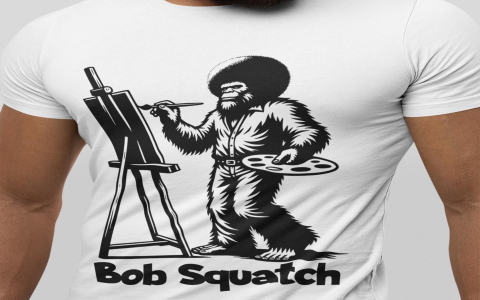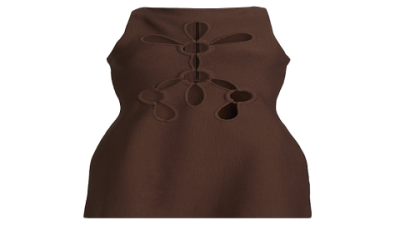You know what's weird? I was watching Bob Ross reruns the other night (don't judge me, it's surprisingly therapeutic after a stressful day), and I started thinking about how this soft-spoken guy with his perfectly permed hair managed to create what might be the most satisfying sound in television history. That sharp thwack-thwack-thwack of his brush hitting the easel while he'd mutter "beat the devil out of it" – honestly, it's better than ASMR.
And now that exact phrase is plastered across t-shirts everywhere. Which got me wondering – how did we get from a gentle painting instructor cleaning his brushes to what's basically become a cultural battle cry for creative types? The answer is more fascinating than you'd think, and it says a lot about what we're all desperately searching for in our chaotic, always-online world.
The Man Behind The Magic (And The Mess)
Robert Norman Ross wasn't trying to become a meme when he started "The Joy of Painting" back in 1983. Hell, the guy probably didn't even know what a meme was. Born in Daytona Beach in 1942, Ross took one of those classic American journeys – from military sergeant to beloved TV personality. But here's the thing that always gets me: he developed his painting skills while stationed in Alaska, of all places, as a way to deal with military stress.
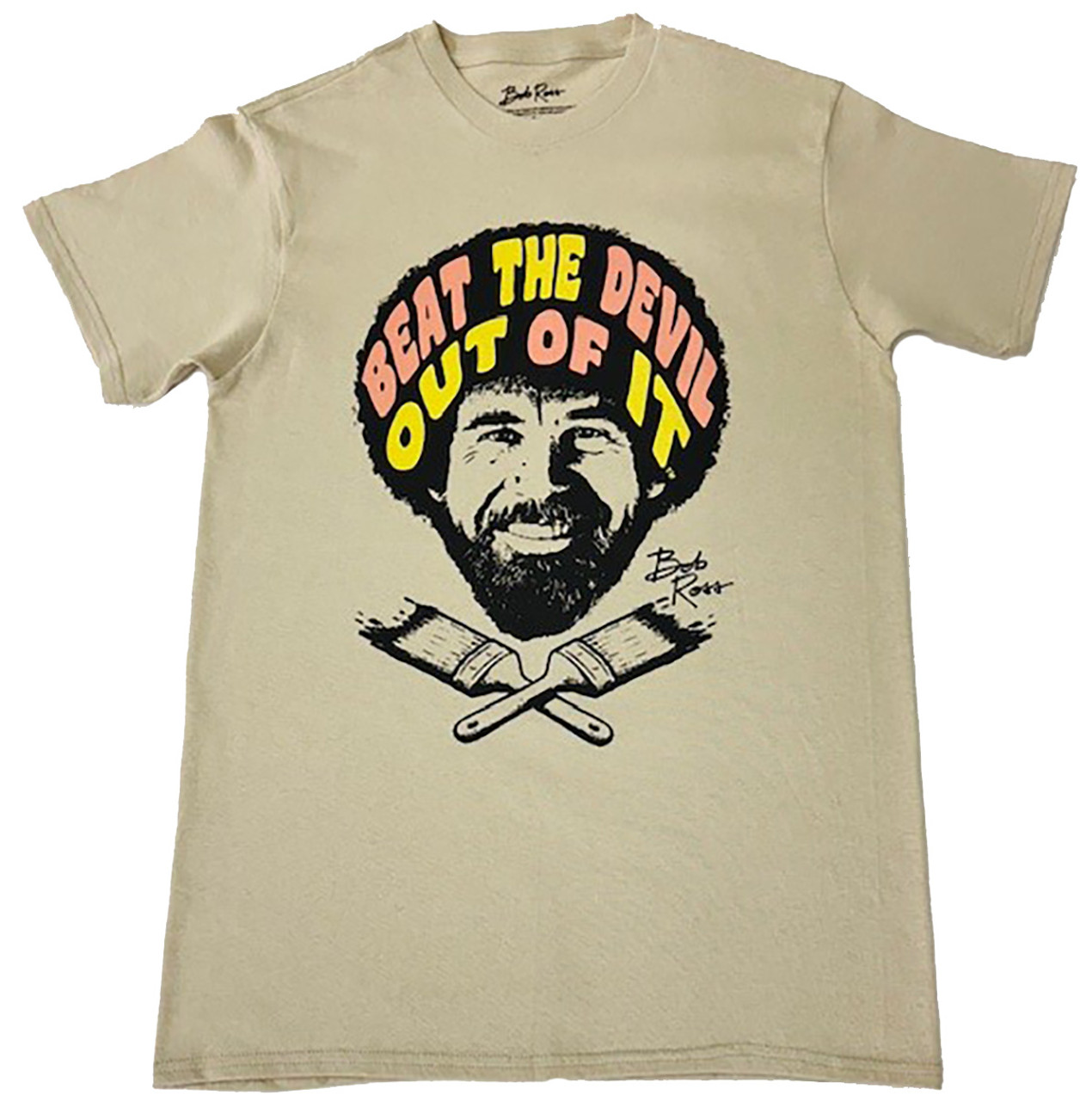
Picture this – you're stuck in freezing Alaska, dealing with military bureaucracy and probably homesick as anything, so you start painting landscapes. There's something beautifully ironic about Ross finding his calling in one of the most isolated, harsh environments possible, only to later become synonymous with peace and tranquility.
The "beat the devil out of it" phrase came naturally from his teaching style. See, when you're doing wet-on-wet oil painting (which sounds way more complicated than it actually is), you absolutely have to clean your brushes thoroughly between colors. Otherwise, you end up with muddy messes instead of those crisp, clean lines Ross was famous for. So instead of gently dabbing like most people might do, Ross would just go to town on that easel – whack, whack, whack – until every trace of paint was gone.
What made it special wasn't just the technique though. It was the contrast. Here's this incredibly patient man who could spend twenty minutes explaining how to paint a single cloud, and then suddenly he's aggressively beating brushes like he's got a personal vendetta against paint residue. That dichotomy – the zen master having his one moment of controlled chaos – that's what hooked people.
Why This T-Shirt Thing Actually Makes Perfect Sense
I'll be honest, when I first saw someone wearing a "beat the devil out of it" shirt at a coffee shop last year, my initial reaction was "okay, that's random." But the more I thought about it, the more it clicked. We're living in this bizarre time where everything feels performative and fake, right? Social media has us all pretending our lives are Instagram-perfect, work demands we be "always on," and somehow we're supposed to find inner peace through meditation apps that send us push notifications.
Enter Bob Ross merchandise, and suddenly it all makes sense. These aren't just t-shirts – they're like wearing a philosophy. When someone rocks a Bob Ross quote, they're basically saying "I value authenticity, I appreciate slow processes, and I'm not afraid to acknowledge that sometimes you need to get a little aggressive to create something beautiful."
The psychology behind it is actually pretty brilliant. Millennials and Gen Z grew up during economic uncertainty, climate anxiety, and social media pressure. Then they discover this guy from the 80s who's telling them it's okay to make mistakes (he called them "happy accidents," remember?), that creativity is more important than perfection, and that sometimes the best therapy is just making something with your hands.
Plus – and I think this is huge – Bob Ross represented competence without arrogance. He clearly knew what he was doing, but he never made you feel stupid for not knowing. In our current landscape of internet experts and influencers who seem to know everything about everything, that kind of humble expertise is refreshing as hell.
The commercial appeal is obvious once you think about it. Unlike most pop culture merchandise that's basically just nostalgia cash-grabs, Bob Ross stuff carries actual meaning. When you wear that shirt, you're not just showing you remember a TV show – you're aligning yourself with values that feel increasingly rare: patience, creativity, mental wellness, authentic teaching.
The Art of Not Screwing Up Bob Ross Merch
Here's where things get tricky, and where a lot of companies completely miss the point. Making good Bob Ross merchandise isn't just about slapping his face on a t-shirt and calling it a day. The design has to capture the essence of what made him special, which is harder than it sounds.
I've seen some truly awful Bob Ross shirts – garish colors that would make him roll over in his grave, fonts that look like they came from a 1990s clipart collection, and layouts that somehow manage to make his peaceful philosophy look aggressive and chaotic. It's like they completely missed the memo about what Bob Ross actually represented.
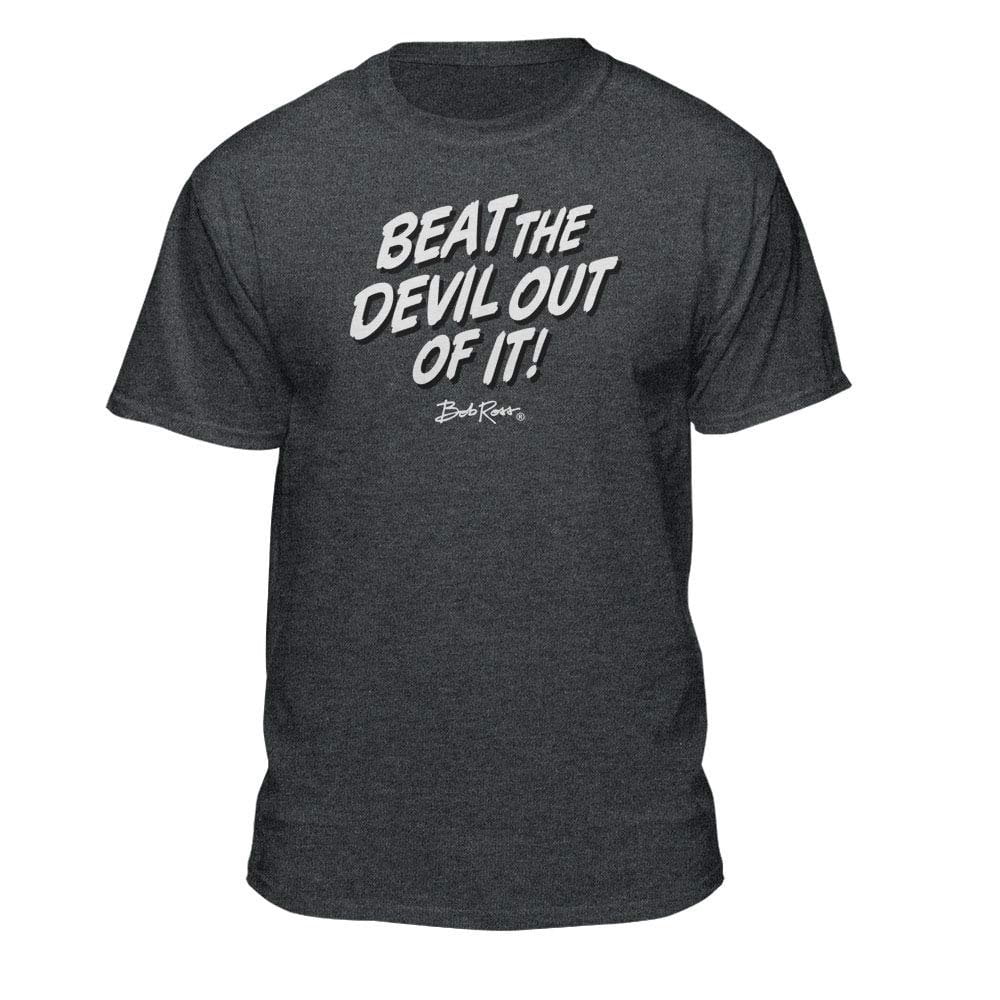
The good stuff? It pays attention to details that matter:
Typography that actually makes sense: The best designs use fonts that feel hand-painted or at least organic. Not some sterile Helvetica knockoff, but something with character that looks like it could have been created with an actual brush.
Colors that connect to his work: Think about Bob Ross's paintings – lots of earthy browns, forest greens, soft blues, warm oranges. The colors should make you think of mountain landscapes and peaceful streams, not a neon rave.
Composition that breathes: Ross's paintings always had this sense of space and calm. Good merchandise reflects that – it's not cluttered or busy, it gives the quote room to exist without competing elements.
| What Works | What Doesn't |
|---|---|
| Earth tones, organic fonts | Neon colors, generic typography |
| Simple, clean layouts | Cluttered, busy designs |
| Quality fabric that ages well | Cheap materials that fall apart |
| Respectful use of imagery | Cartoonish or mocking representations |
And can we talk about fabric quality for a second? Bob Ross was all about that tactile experience – the feel of paint on canvas, the satisfaction of a well-loaded brush. If you're going to make merchandise in his honor, it should feel good to wear. Scratchy, cheap t-shirts that shrink after one wash are basically the opposite of everything he stood for.
How to Actually Wear This Stuff (Without Looking Like a Walking Meme)
Okay, so you've got your Bob Ross shirt. Now what? This is where I see people either nail it or completely miss the mark.
The beauty of a "beat the devil out of it" tee is its versatility, but you've got to think about context. Wearing it to a formal business meeting might send the wrong message (unless you work in a creative field, in which case it might send exactly the right message). But for most casual and even some professional situations? It works beautifully.
I love seeing these shirts paired with well-fitted jeans and maybe a denim jacket or flannel shirt. There's something perfect about that combination – it's relaxed but put-together, creative but not trying too hard. Throw on some worn-in boots or comfortable sneakers, and you've got a look that says "I'm creative, approachable, and I probably give excellent advice about life."
For women, I've seen these shirts styled in ways that would probably make Bob Ross smile – tied at the waist with a flowing skirt, layered under a cardigan with the collar peeking out, or worn oversized with leggings for that perfect "creative but comfortable" vibe.
The seasonal flexibility is another bonus. Summer? Pair it with shorts and sandals for an effortlessly cool look. Fall? Layer it under a cozy sweater with just the text visible. Winter? It works perfectly as a base layer under flannel or as a statement piece with a good jacket.
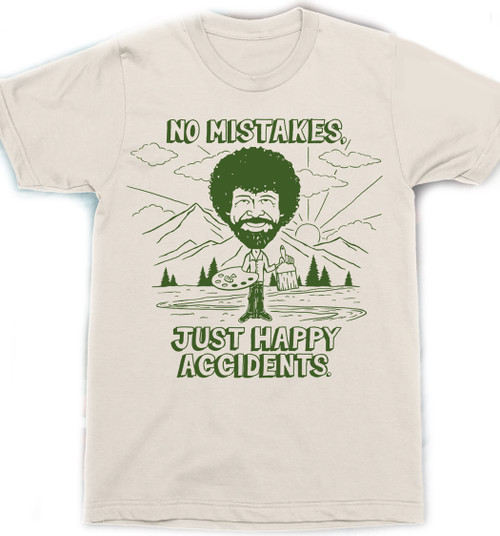
But here's the thing about accessories – keep them authentic to the vibe. Bob Ross wasn't about flash or showing off. Simple leather bracelets, canvas bags, maybe a watch with a leather band. Nothing that screams for attention, because the shirt is already making its statement.
One thing I've noticed about people who wear Bob Ross merchandise well – they usually embody some of his philosophy. They're the ones who'll stop to help a struggling artist, who don't get bent out of shape when plans change, who find joy in simple things. The shirt isn't just fashion for them; it's a reminder of values they actually try to live by.
The Bigger Picture (Pun Intended)
What's really wild to think about is how Bob Ross's influence has exploded in ways he never could have imagined. The guy died in 1995, way before YouTube, way before social media, way before our current mental health awareness movement. Yet somehow his message feels more relevant now than it did when he was actually making the show.
There's this whole generation of people who discovered Bob Ross through YouTube compilations and Twitch streams. They're dealing with college debt, climate anxiety, social media pressure, political chaos – basically everything Bob Ross's gentle philosophy seems designed to counter. And they're finding genuine comfort in watching this soft-spoken guy create beautiful landscapes while occasionally getting mildly aggressive with paint brushes.
Mental health professionals have started using Bob Ross techniques in therapy. Schools are incorporating his teaching methods. Corporate team-building exercises use his philosophy. It's like we collectively realized that maybe, just maybe, this guy from public television had figured out something important about how to live and learn and create without losing our minds.
The environmental angle is interesting too. Ross painted all these gorgeous natural scenes and talked constantly about respecting nature. He wasn't preachy about it – that wasn't his style – but the message was clear: this natural world is worth celebrating and protecting. Now people wear shirts with his quotes as a subtle form of environmental advocacy.
And honestly? In our current world of internet rage and political division, there's something deeply appealing about a cultural figure whose entire brand was basically "let's all be kind to each other and make something beautiful." No controversy, no scandals, just a guy who wanted to teach people that creativity was accessible to everyone.
Questions People Actually Ask About This Stuff
What did "beat the devil out of it" actually mean when Bob Ross said it?
It was literally about cleaning paint brushes really thoroughly. Ross used wet-on-wet oil painting techniques, which means you absolutely have to clean your brushes completely between colors or you end up with muddy messes. The "devil" was basically any leftover paint that could ruin your next color application. So he'd whack those brushes against the easel until they were completely clean.
Why is Bob Ross merchandise suddenly everywhere?
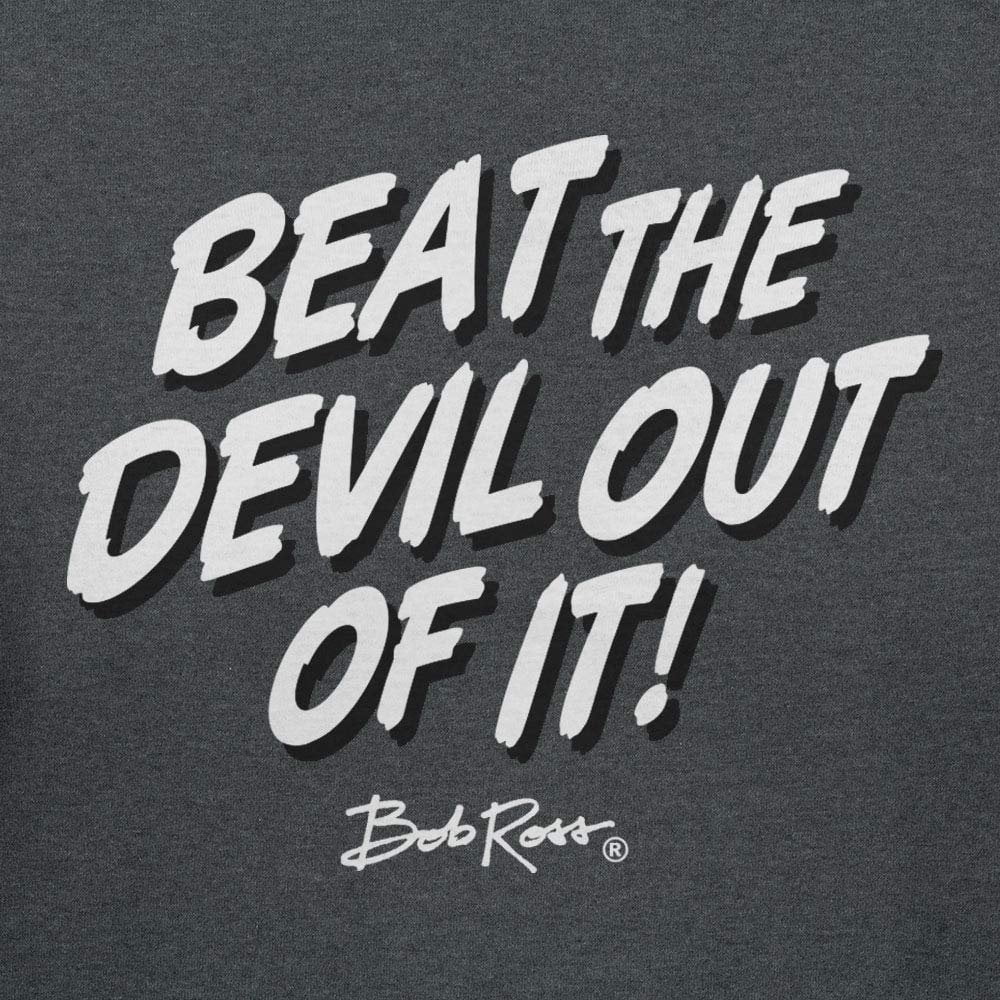
A few things happened at once: YouTube made his old shows accessible to new generations, mental health awareness increased (and his philosophy aligns perfectly with mindfulness practices), plus there's this broader cultural craving for authenticity in our fake-everything digital world. His message of patient creativity and accepting imperfection hits different when you're stressed about student loans and climate change.
How can I tell if a Bob Ross shirt is actually good quality?
Look for soft, substantial fabric that won't shrink to doll-size after one wash. The design should use colors that actually relate to his art – earth tones, not neon garbage. Typography should feel organic, not like it was created in Microsoft Word. And honestly, if the price seems too good to be true, it probably is. Good Bob Ross merch requires proper licensing, quality materials, and thoughtful design.
Can companies just use Bob Ross quotes without permission?
Nope. His name, image, and show content are legally protected. Bob Ross Inc. handles licensing, so legitimate merchandise has to go through proper channels. If you see suspiciously cheap Bob Ross stuff on random websites, it's probably bootleg. Stick with authorized retailers if you want to support his actual legacy rather than some random person stealing his likeness.
How should I wash my Bob Ross t-shirt so it doesn't fall apart?
Cold water, inside-out, gentle cycle. Skip the bleach (Ross would probably have strong feelings about chemicals anyway). Air dry if possible – heat is the enemy of printed graphics. Basically treat it like you'd treat a piece of art, because in a way, that's what it is.
What other Bob Ross quotes work well on shirts?
"Happy little trees" is probably the most popular, followed by "Happy accidents" and "There are no mistakes, only happy accidents." Each one appeals to slightly different people – "happy trees" is more whimsical, "happy accidents" is philosophical. Pick the one that speaks to your personal interpretation of his message.
Where can I buy authentic Bob Ross merchandise?

Official websites, licensed retailers, some art supply stores. Be wary of random online sellers with prices that seem too good to be true. The official Bob Ross website has a list of authorized retailers. Amazon can be hit-or-miss – check that the seller is actually licensed.
The Bottom Line
Look, at the end of the day, a "beat the devil out of it" Bob Ross shirt is just a piece of clothing. But it's also kind of not, you know? It's a statement about what you value, what brings you comfort, what you think is worth celebrating in our increasingly chaotic world.
When I see someone wearing one of these shirts, I make assumptions – probably good ones. I assume they're creative, or at least appreciate creativity. I assume they value patience and process over quick fixes and instant gratification. I assume they've probably got a good sense of humor and don't take themselves too seriously. Maybe I'm wrong sometimes, but probably not often.
The fact that Bob Ross's gentle philosophy has translated so perfectly into wearable form says something hopeful about where we're headed as a culture. Despite all the noise and chaos and division, there's still a huge appetite for kindness, creativity, and authentic wisdom. Sometimes that wisdom comes from the most unexpected places – like a soft-spoken painter who got a little aggressive with his brushes and accidentally created one of the most satisfying sounds in television history.
So whether you're buying the shirt as a tribute to childhood memories of watching PBS, as a conversation starter about art and creativity, or just because you love the idea of beating devils out of things (metaphorically speaking), you're participating in something bigger than fashion. You're keeping alive a philosophy that feels both nostalgic and urgently contemporary: that creativity is healing, imperfection is beautiful, and sometimes the best way to solve a problem is to get a little aggressive with your tools.
Bob Ross probably never imagined his brush-cleaning technique would end up on t-shirts worn by people decades after his death. But somehow, it feels exactly right. After all, he always said there were no mistakes, only happy accidents. And in a world that often feels like it's full of unhappy accidents, wearing a reminder of that philosophy seems like a pretty reasonable choice.
